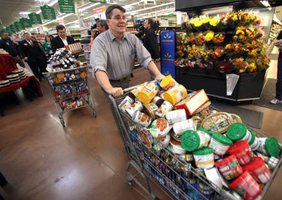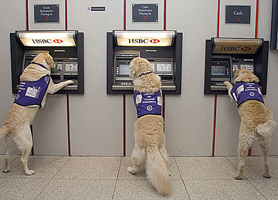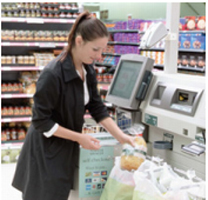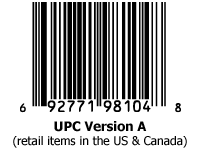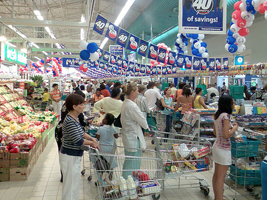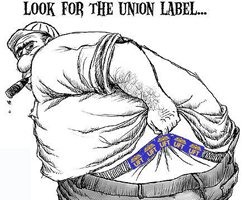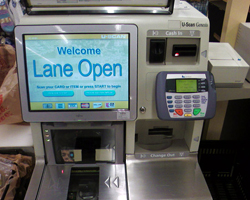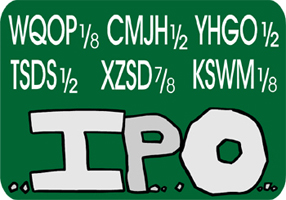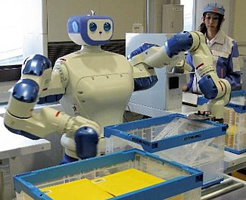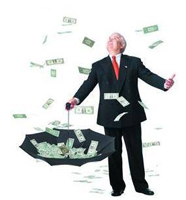Archive
Ice Hockey and Rugby Players Now in Your Local Supermarket
Nothing lends more credence to the viewpoint that today some people think more about themselves and behave in a seemingly narcissistic manner than by walking the aisles of their local supermarket. One thing that is certain is that manners seem to be something that is left at the front door when some individuals pull a shopping cart out of the row at the front of the store.
I have often wondered if the reason for some of the behavioral traits that I will write about in this post originate in the early days of mankind when we hunted for our own foods – the times of the cave man. Back then we fiercely competed with one another to bring down a wild animal that could fill our stomachs with much-needed sustenance and for the most part we did not want anyone else hording in on our kill. To me these primitive traits are especially prevalent in today’s supermarket meat and deli departments but more on that a little bit later in this post.
So let’s begin now with an example of some of these peculiar shopping habits. Some people use the grocery cart to stalk and capture their prey. Shopping cart etiquette begins when one selects a shopping cart or lasso’s it from the cart corral so to speak. This etiquette ends when you put the cart away at the end of your shopping trip – if you even do that.

First though let’s talk trash. The trash that I would like to talk about here is the type that a previous shopper leaves in a shopping cart for someone else to deal with. In today’s supermarket labor environment there just does not seem to be the resources to keep the shopping carts as clean as they should be and we put our food in these carts. Anyway this type of rude behavior can set the tone for a shoppers food purchase experience and it might not be a pleasant one at that.
I have seen, as well as been a victim of, shopping cart trashing syndrome. Having a store’s paper advertisement laying somewhere in the cart is not the type of trashing that I am referring to. No I am referring to the spilled coffee, empty coffee cups, crumbs from fast food establishments that a previous shopper had left in the cart. Another example is the smashed produce items in a plastic bag that some how got damaged between checking out and being tossed into the family mini van for the trip home. Tomato drippings, banana ooze and apple chunks along with leaking milk or spilled hot soup can make for a slippery shopping cart. One of the most disgusting examples of leaving one’s trash in a shopping cart is the used Kleenex or tissue. This just flat-out makes me want to heave. How can someone wipe their nose or their mouth in something and then leave it in a shopping cart? My favorite instance of extreme shopping cart trashing was when a customer, in a store that I was working at, brought a used diaper to the counter and said that it was left in the shopping cart she was using and could we dispose of it for them. Well at least that it was not a used Depends.
Anyway some people just live like swine and the common courtesy that one should exercise by taking their personal trash from the shopping cart before they push it into the middle of the road or cart corral is for the most part lost on them.

Back to our shopping trip now. With your narrator now in control of their wobbly wheeled shopping cart they begin their journey up and down the aisles of the store doing the hunter gatherer thing.
What I have really begun to fear at my own local grocery store is the Denny Crane like senior citizen, though they might not be carrying a firearm like Denny always seemed to be doing on Boston Legal, some seniors seem to use the shopping cart as their weapon of choice with which to wreak mayhem throughout the store.
Senior citizens seem to be most forceful in the dairy department. Is it their pressing need for yogurt or cottage cheese? Perhaps it is the juices that are commonly found in this department. Whatever the heck it is I can tell you that standing in front of a dairy case for more that 10 seconds can subject a shopper to a body check that would please any member of the audience watching the Montreal Canadians playing the Chicago Blackhawks. My knees have been bumped and checked by numerous 70-year-old seniors on more than several occasions.
While today’s supermarkets do not have yellow lines painted on their floors or traffic signals like roadways do there is an unwritten directional map that 99% of us follow when we are in the supermarket. Most people know that we go in the front door of a store then we follow the crowd around the perimeter of a store as we navigate up and down the center aisles as we go. The senior citizen either does not remember these mental directional maps or chooses to ignore them by claiming some form of mad cow disease.
Last week I was shopping in my local supermarket when I found myself in the dairy department and was immediately mesmerized by a shelf containing 16 or 17 types of yogurt. It took me a few seconds to decide what variety of this custard looking yogurt to take off the shelf when I felt a searing pain shooting up my leg from the area of my knee. As I looked down at my leg I saw that there was a shopping cart attached to my body exactly at knee level. At the handle of that shopping cart was a very prim and properly dressed white-haired lady roughly born about 20 years before Ronald Reagan. Of course she slammed into me from the opposite direction of the store’s normal traffic flow especially for that particular area. This proverbial little old lady stood about 4 foot 8 inches with an obvious calcium deficiency. No wonder I did not see her coming at me since she was short and on the wrong side of the road so to speak. Well she wanted in at the yogurt and nothing was going to stop her for getting to it not even my now wounded knee. There was no excuse me or an apology uttered from her lips instead there was just a self-absorbed look that also said out of my way you jerk.
Have you ever noticed how today’s grocery shopper is forced to confront all of the product displays in the shopping aisles? It used to be that a shopper would see a few of these product displays in the aisles during certain holidays like the aluminum pans around Thanksgiving or perhaps a promotional display from one of the sugar-water producers for a product featuring the image of some hyped up athlete.
Anyway pushing one’s basket up and down the aisles in the store today requires that the shopper dodge more of these numerous product displays that have been placed almost everywhere in the store. I guess these stores get promotional money or pay less for the products in these floor displays but that topic is for another post. In addition to dodging these promotional obstacles a shopper has to be aware that these displays can also be used as a refuge for some shoppers that wish to spring an ambush on their prey so to speak.
A few months back I was making my way through the spice aisle and all of a sudden, from behind a 5+ foot high floor product display for some new sugar substitute my shopping cart was t-boned by another cart even though I was not in the meat department. Apparently some shopper, a short one at that, had pushed their cart to the side of the previously mentioned floor display and was carrying on a conversation on their cell phone.
I do not know what made me more upset the fact that they were able to get phone reception in this store, because I never can, or that they slammed into my cart while they were talking on the phone obviously not looking where they were going or who might be around – kind of like the way some people drive today.
Well after the two of us eyed each other for a moment possibly waiting for the other one to say something the driver of the other shopping cart did not miss a beat with her phone conversation and now was slowly proceeding up the aisle away from me. I was thinking about running after her and demanding her driver’s license and proof of insurance or at least insist that we should exchange our stores valued customer saving card information but it was too late as another customer curtly said “excuse me” because I was now blocking the narrow aisle.
To be continued on another post.
AB
Copyright @ 2010 Supermarket Stories
